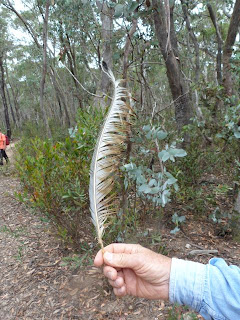ANPS ties up to a Bollard
The first couple of kms from the cars seemed to be a bit undulating on the way in, but after the ascent of the peak seemed quite flat on the way back. In both directions the main tree cover is Eucalyptus dives.
That habitat is shown in the background to "father of the day" - OK the typo is deliberate (for once) - left behind by a Superb Lyrebird.
On reaching the base of the Mountain itself the track turned skywards through much larger trees (Eucalyptus fastigata, E. radiata and E. dalrympleana) with little understorey - I presume that when water falls on a 1:3.5 (28%) slope it doesn't hang around to facilitate shrub growth. This shows a view from about 1/3rd the way up (or indeed, down) with the less hardy (aka more sensible) souls visible at the foot of the peak.
At the top we were into Eucalyptus pauciflora (Snow gums) and while flat, there was not a lot of soil as indicated by the rocky outcrops.
Some details of plants, beginning with the dicotyledons. The commonest flower of the day was IMHO the lovely purple Comesperma ericinum.
The Dianella had all finished flowering but these berries on D tasmanica - I think - were very attractive.
We now move to Persoonias. P chamaepeuce is a low growing, almost prostrate plant
while P silvatica is a reasonable sized bush.
At the top of the hill/cliff we found this plant which I originally labelled "not-Pimelia" but was in fact Platysace lanceolata.
Right at the start of the track in was a yellow Stackhousia viminea.
Now to deal with the orchids. The first of these was found by a member well away from the track. This was a Chiloglottis trilabra,
and it was suggested that this removed the key justification for going up the mountain. No, no! The key justification is indeed 'Because it is there'! However once up we found and snapped several more of this species.
At base camp those who didn't ascend found a good collection of Diplodium dercurvum, the aptly named Summer Greenhood.
We also found two examples of Thynninorchis huntiana, an elbow orchid. As I have already got a good image of this I didn't join the queue to snap the first and was a good distance away when Frances found the second and took a photo (from the randy wasp's view).
Arthropods were very prevalent. I suspect several members had a spider sandwich while walking off -piste. Here we have some arachnids at work.
Of course they only get to be that big if they eat lots of stuff. Here we have another spider doing the eating bit.
The less fortunate member of this duo is the larva of a Chrysomelid leaf beetle. If it had not been elected "nosh du jour" by the spider it might have grown into something pretty like this.
A luckier (thus far) larval stage is this one, with an overall view and a close up of the front end:
The final arthropodic addition to this post is a lantern fly: actually a leaf-hopper.
Not all the animals were tiny. This one was about 1.2m long
It was a Yellow-bellied Black Snake, often called a Copperhead. Rather venomous, but also very keen to remove itself from our presence.
There were a few birds around but not a great abundance. This possibly reflects the limited range of insects (which probably reflects the limited range of flowers.
To finish there was only one fungus seen all day. I don't think it is an Amanita sp but still wouldn't cook it!




























Comments